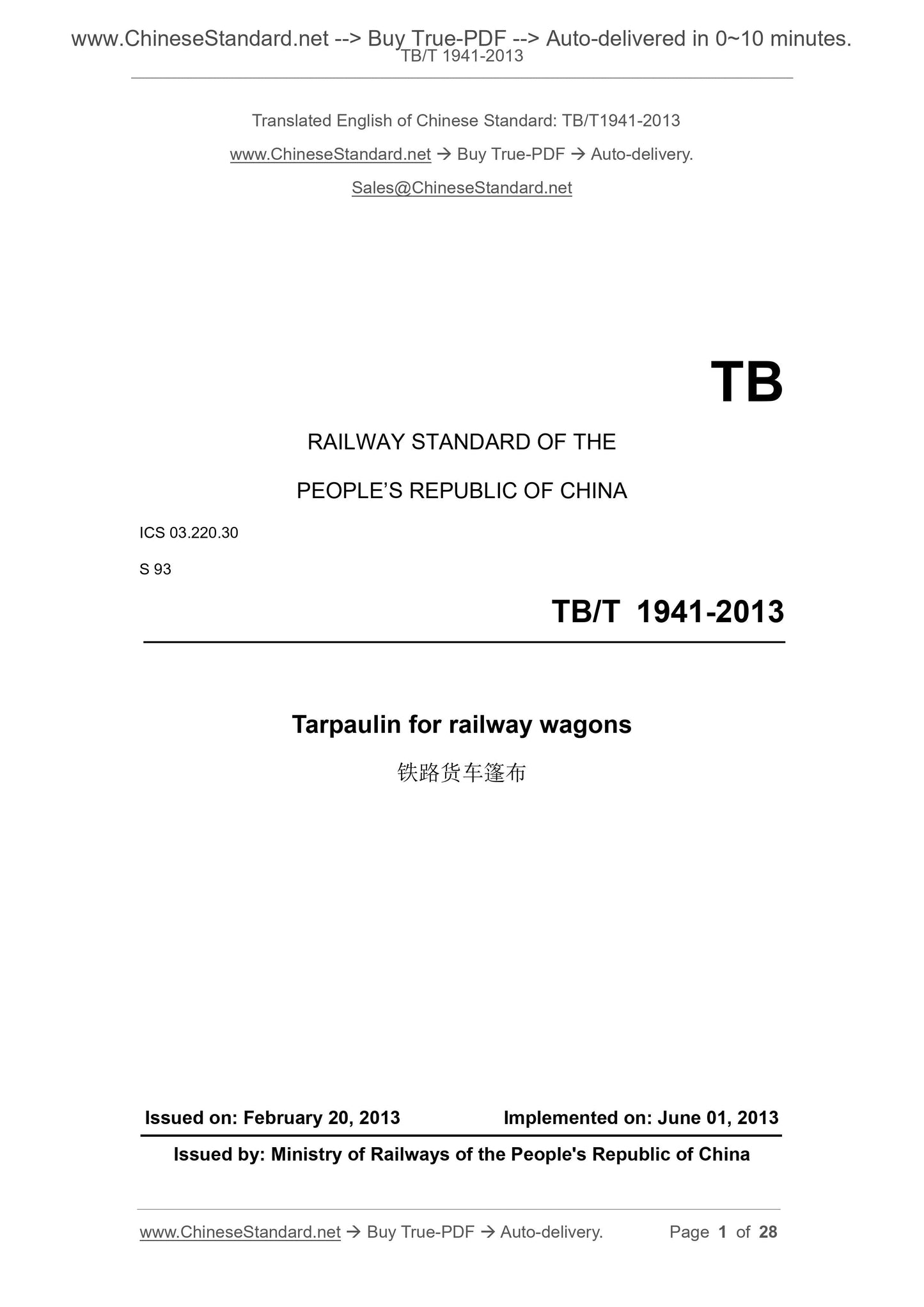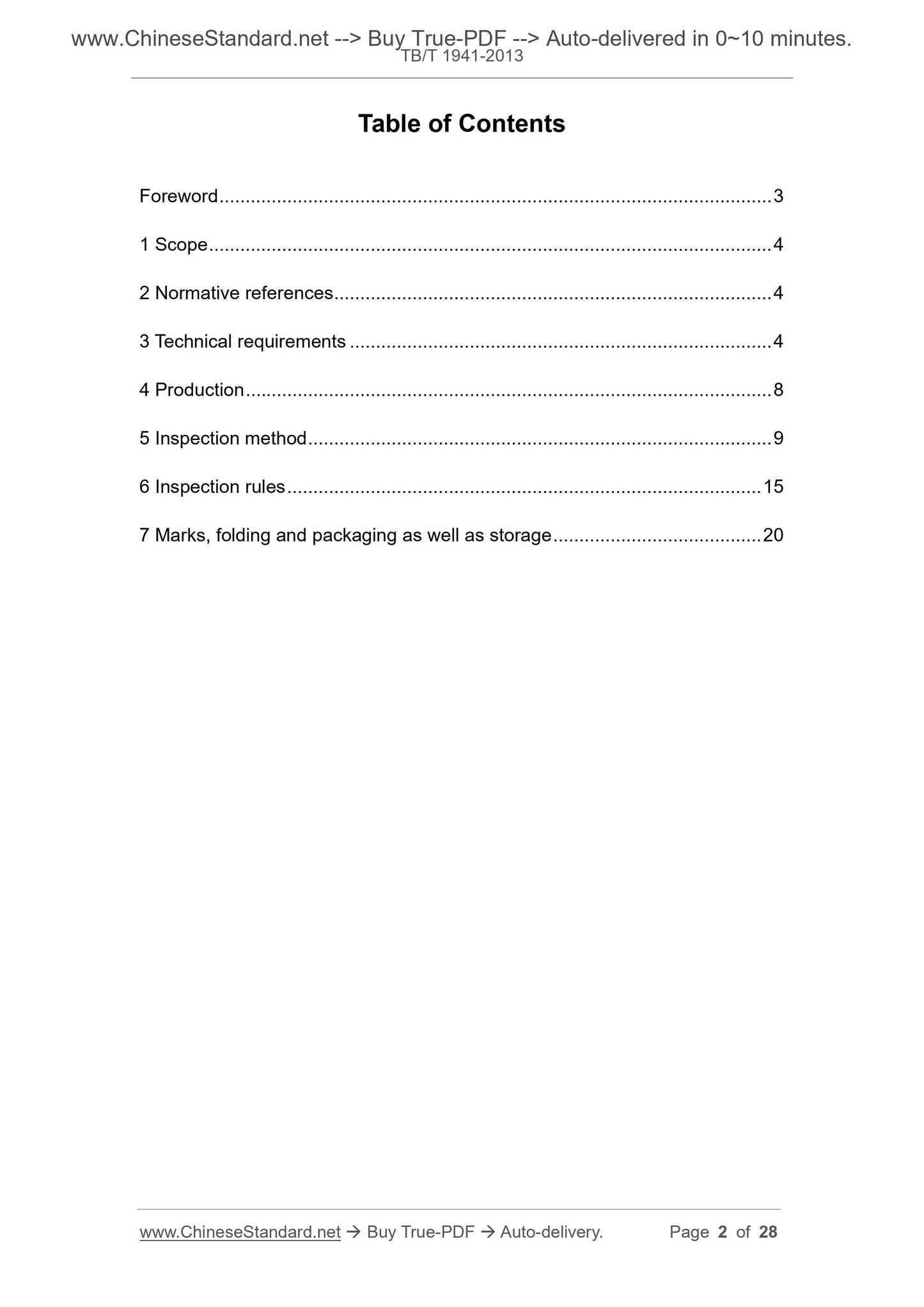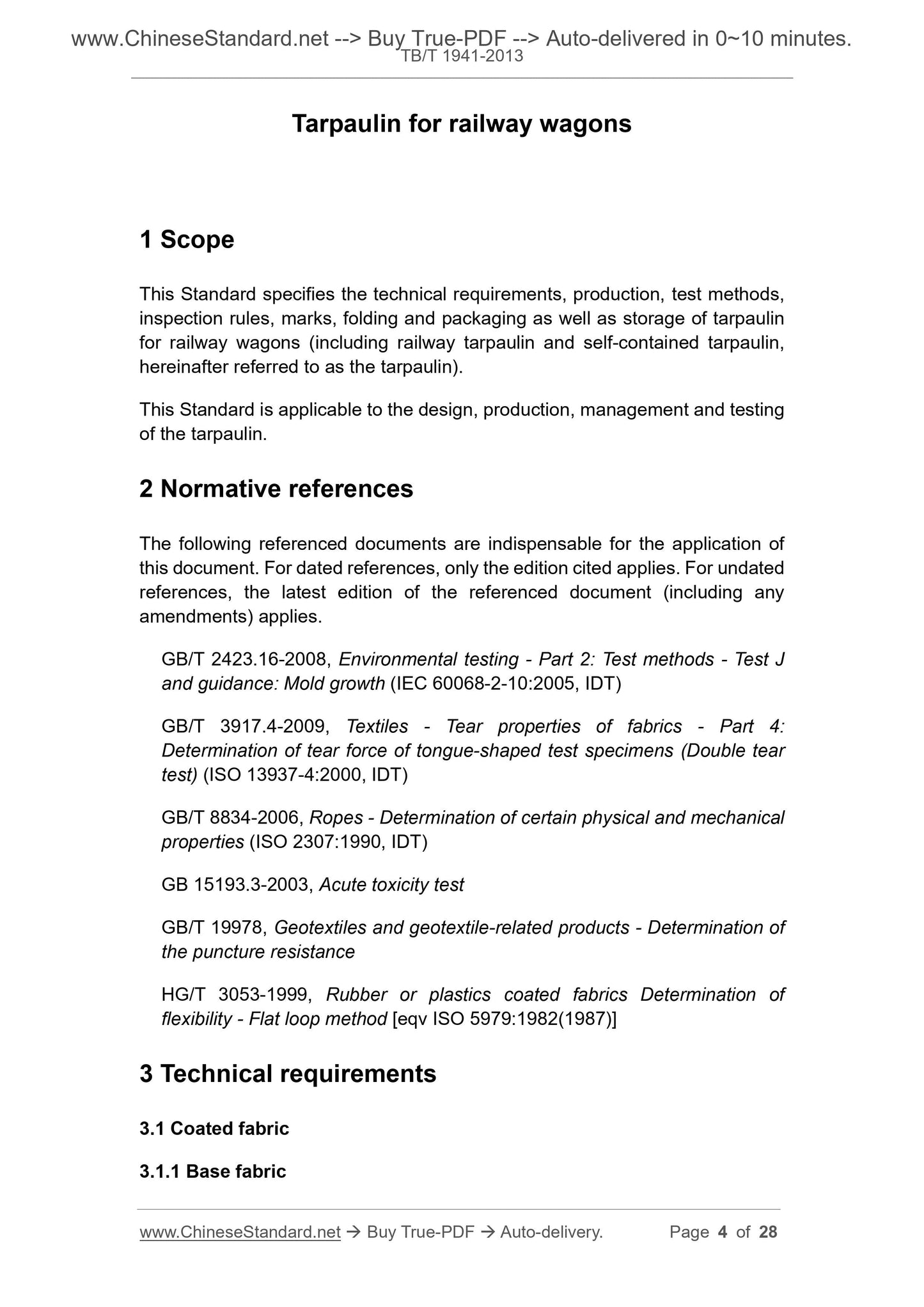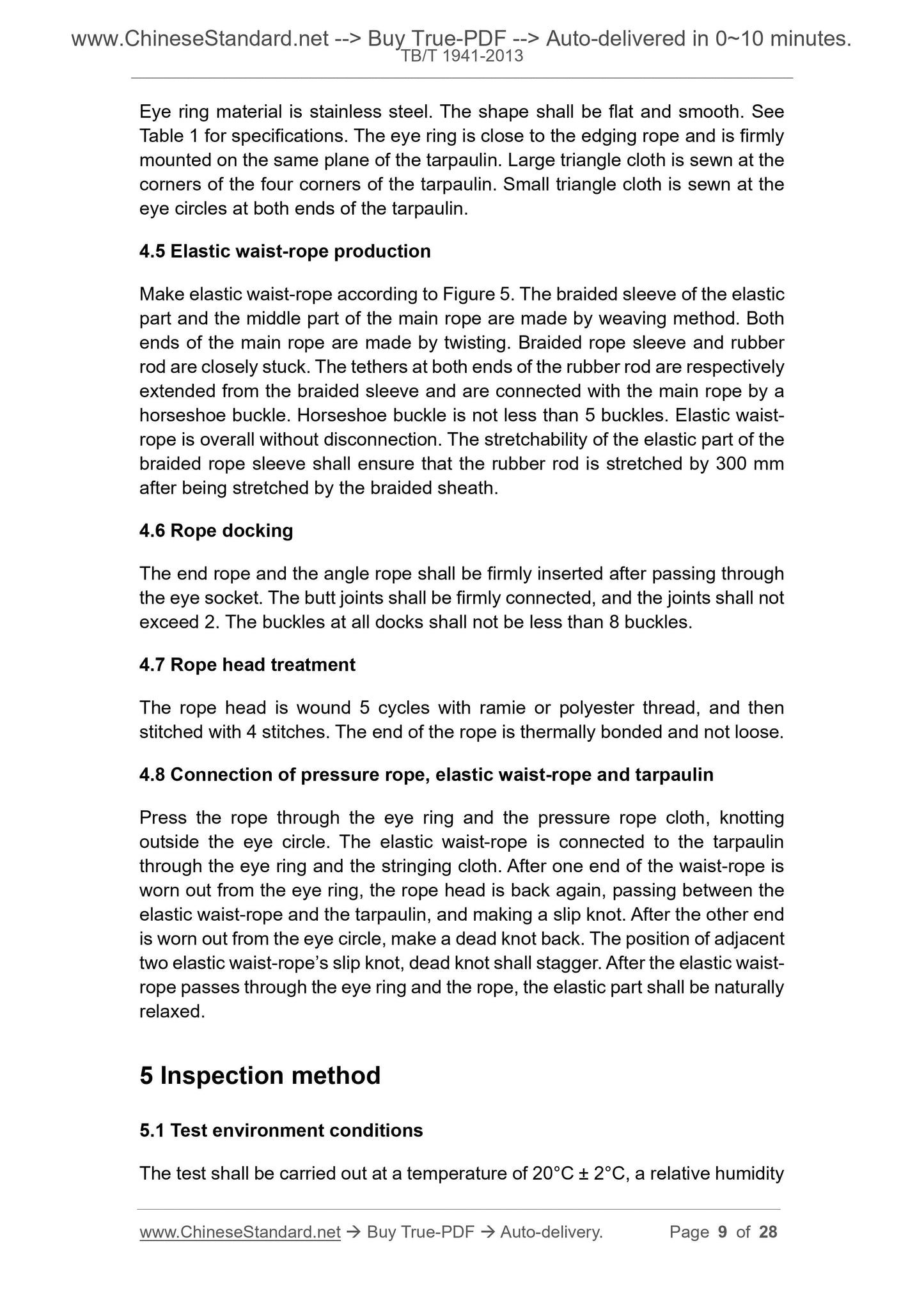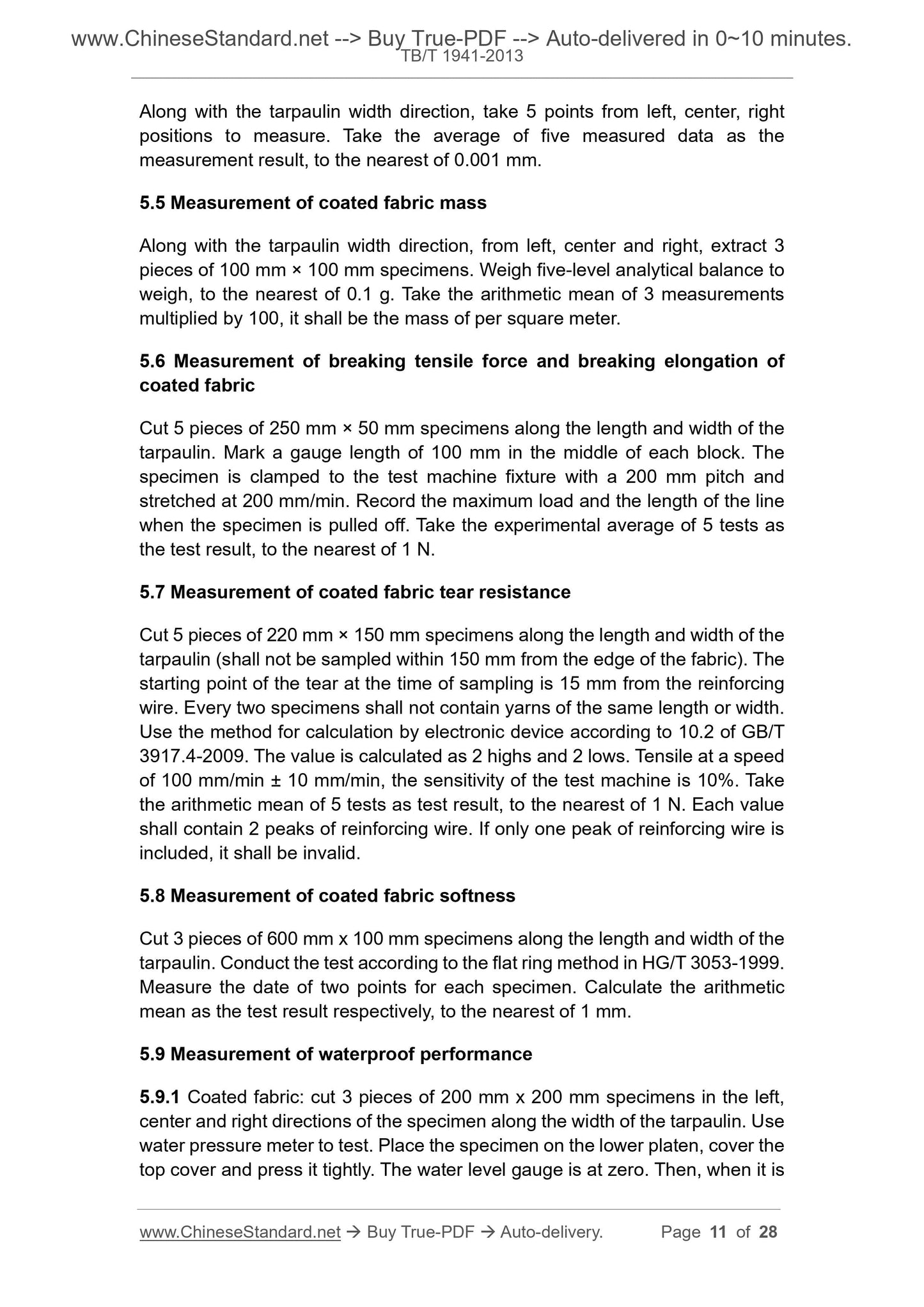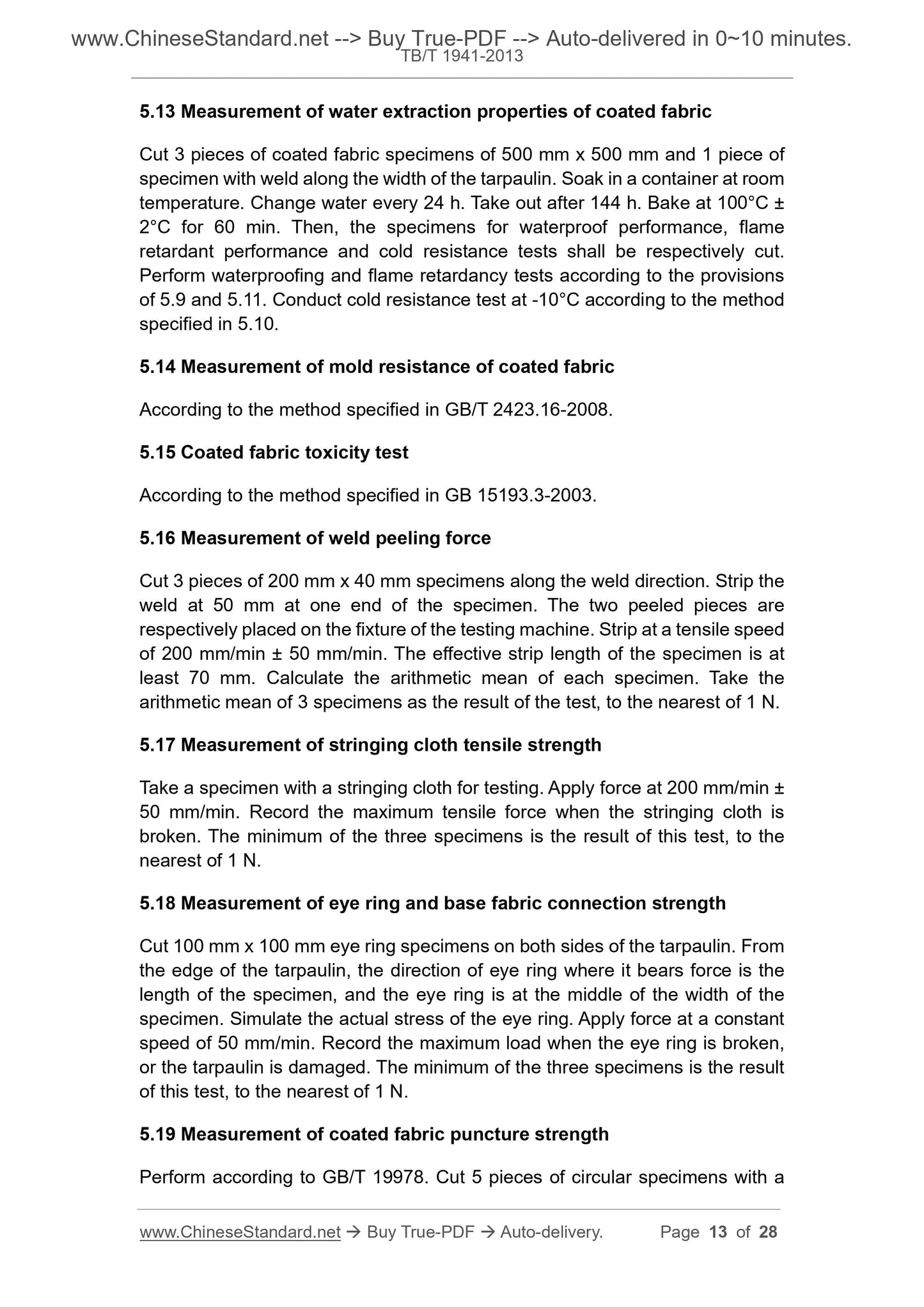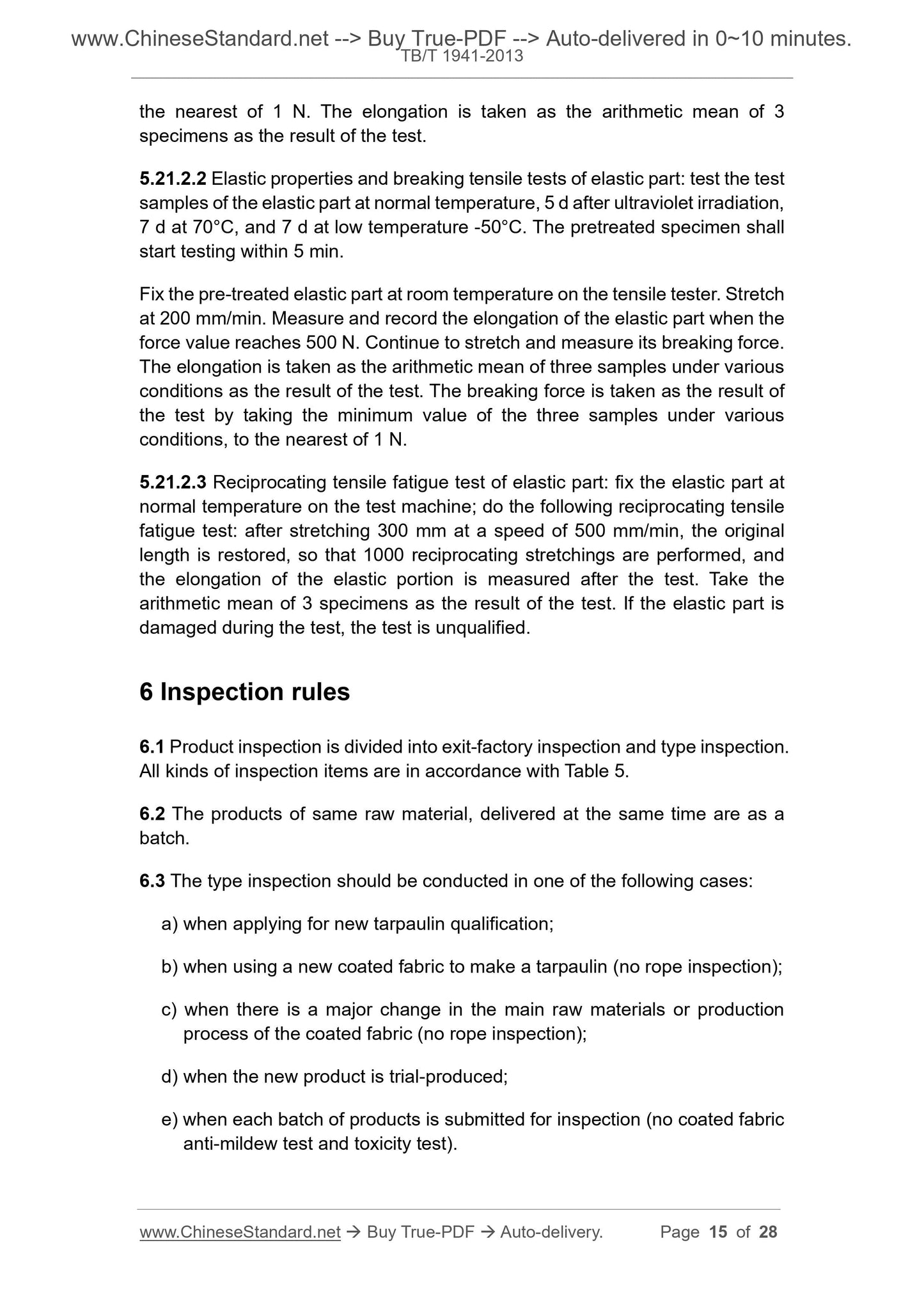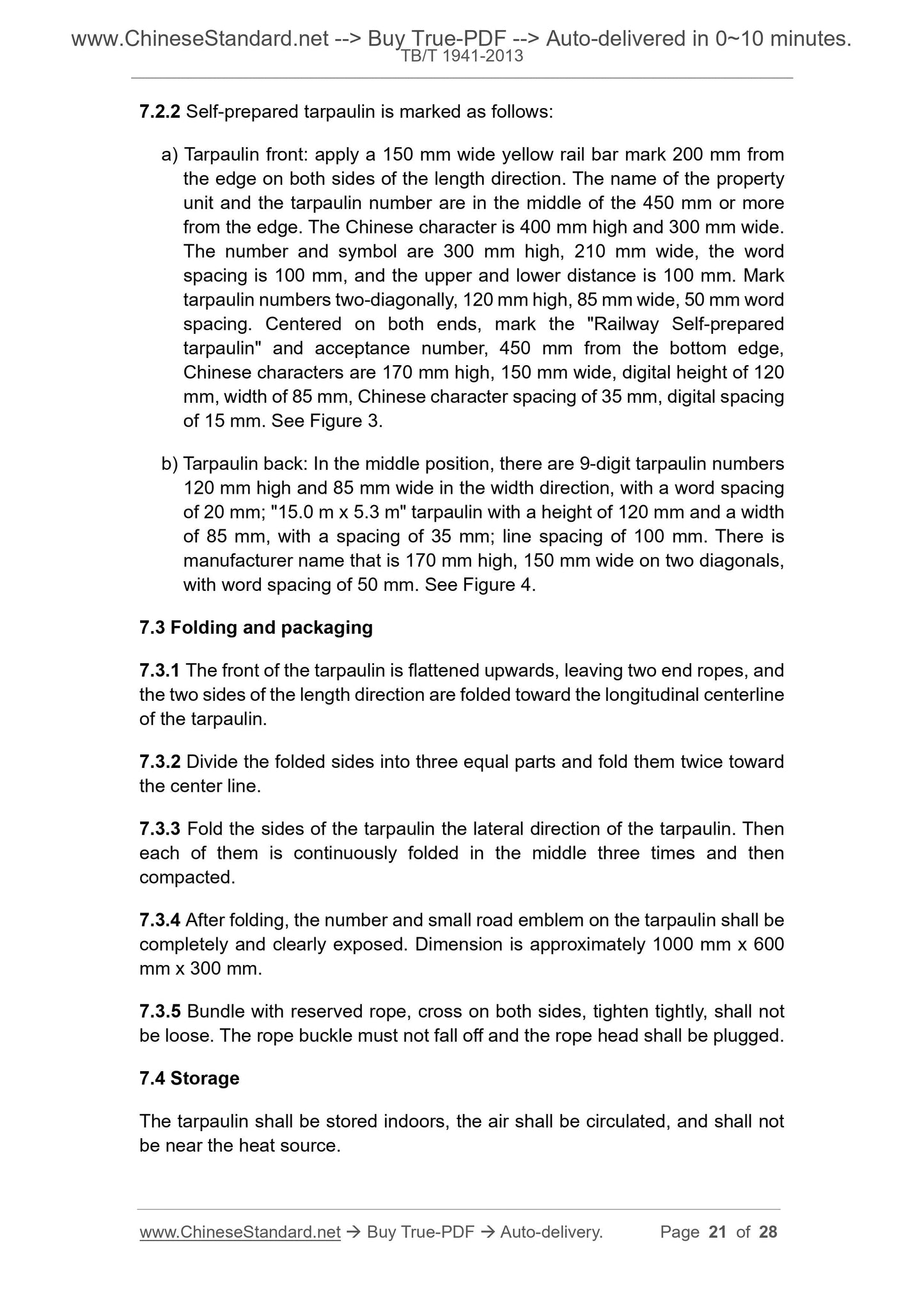1
/
trong số
8
PayPal, credit cards. Download editable-PDF and invoice in 1 second!
TB/T 1941-2013 English PDF (TBT1941-2013)
TB/T 1941-2013 English PDF (TBT1941-2013)
Giá thông thường
$170.00 USD
Giá thông thường
Giá ưu đãi
$170.00 USD
Đơn giá
/
trên
Phí vận chuyển được tính khi thanh toán.
Không thể tải khả năng nhận hàng tại cửa hàng
Delivery: 3 seconds. Download true-PDF + Invoice.
Get QUOTATION in 1-minute: Click TB/T 1941-2013
Historical versions: TB/T 1941-2013
Preview True-PDF (Reload/Scroll if blank)
TB/T 1941-2013: Tarpaulin for railway wagons
TB/T 1941-2013
TB
RAILWAY STANDARD OF THE
PEOPLE’S REPUBLIC OF CHINA
ICS 03.220.30
S 93
Tarpaulin for railway wagons
ISSUED ON. FEBRUARY 20, 2013
IMPLEMENTED ON. JUNE 01, 2013
Issued by. Ministry of Railways of the People's Republic of China
Table of Contents
Foreword ... 3
1 Scope ... 4
2 Normative references ... 4
3 Technical requirements ... 4
4 Production ... 8
5 Inspection method ... 9
6 Inspection rules ... 15
7 Marks, folding and packaging as well as storage ... 20
Tarpaulin for railway wagons
1 Scope
This Standard specifies the technical requirements, production, test methods,
inspection rules, marks, folding and packaging as well as storage of tarpaulin
for railway wagons (including railway tarpaulin and self-contained tarpaulin,
hereinafter referred to as the tarpaulin).
This Standard is applicable to the design, production, management and testing
of the tarpaulin.
2 Normative references
The following referenced documents are indispensable for the application of
this document. For dated references, only the edition cited applies. For undated
references, the latest edition of the referenced document (including any
amendments) applies.
GB/T 2423.16-2008, Environmental testing - Part 2. Test methods - Test J
and guidance. Mold growth (IEC 60068-2-10.2005, IDT)
GB/T 3917.4-2009, Textiles - Tear properties of fabrics - Part 4.
Determination of tear force of tongue-shaped test specimens (Double tear
test) (ISO 13937-4.2000, IDT)
GB/T 8834-2006, Ropes - Determination of certain physical and mechanical
properties (ISO 2307.1990, IDT)
GB 15193.3-2003, Acute toxicity test
GB/T 19978, Geotextiles and geotextile-related products - Determination of
the puncture resistance
HG/T 3053-1999, Rubber or plastics coated fabrics Determination of
flexibility - Flat loop method [eqv ISO 5979.1982(1987)]
3 Technical requirements
3.1 Coated fabric
3.1.1 Base fabric
Eye ring material is stainless steel. The shape shall be flat and smooth. See
Table 1 for specifications. The eye ring is close to the edging rope and is firmly
mounted on the same plane of the tarpaulin. Large triangle cloth is sewn at the
corners of the four corners of the tarpaulin. Small triangle cloth is sewn at the
eye circles at both ends of the tarpaulin.
4.5 Elastic waist-rope production
Make elastic waist-rope according to Figure 5. The braided sleeve of the elastic
part and the middle part of the main rope are made by weaving method. Both
ends of the main rope are made by twisting. Braided rope sleeve and rubber
rod are closely stuck. The tethers at both ends of the rubber rod are respectively
extended from the braided sleeve and are connected with the main rope by a
horseshoe buckle. Horseshoe buckle is not less than 5 buckles. Elastic waist-
rope is overall without disconnection. The stretchability of the elastic part of the
braided rope sleeve shall ensure that the rubber rod is stretched by 300 mm
after being stretched by the braided sheath.
4.6 Rope docking
The end rope and the angle rope shall be firmly inserted after passing through
the eye socket. The butt joints shall be firmly connected, and the joints shall not
exceed 2. The buckles at all docks shall not be less than 8 buckles.
4.7 Rope head treatment
The rope head is wound 5 cycles with ramie or polyester thread, and then
stitched with 4 stitches. The end of the rope is thermally bonded and not loose.
4.8 Connection of pressure rope, elastic waist-rope and tarpaulin
Press the rope through the eye ring and the pressure rope cloth, knotting
outside the eye circle. The elastic waist-rope is connected to the tarpaulin
through the eye ring and the stringing cloth. After one end of the waist-rope is
worn out from the eye ring, the rope head is back again, passing between the
elastic waist-rope and the tarpaulin, and making a slip knot. After the other end
is worn out from the eye circle, make a dead knot back. The position of adjacent
two elastic waist-rope’s slip knot, dead knot shall stagger. After the elastic waist-
rope passes through the eye ring and the rope, the elastic part shall be naturally
relaxed.
5 Inspection method
5.1 Test environment conditions
The test shall be carried out at a temperature of 20°C ± 2°C, a relative humidity
Along with the tarpaulin width direction, take 5 points from left, center, right
positions to measure. Take the average of five measured data as the
measurement result, to the nearest of 0.001 mm.
5.5 Measurement of coated fabric mass
Along with the tarpaulin width direction, from left, center and right, extract 3
pieces of 100 mm × 100 mm specimens. Weigh five-level analytical balance to
weigh, to the nearest of 0.1 g. Take the arithmetic mean of 3 measurements
multiplied by 100, it shall be the mass of per square meter.
5.6 Measurement of breaking tensile force and breaking elongation of
coated fabric
Cut 5 pieces of 250 mm × 50 mm specimens along the length and width of the
tarpaulin. Mark a gauge length of 100 mm in the middle of each block. The
specimen is clamped to the test machine fixture with a 200 mm pitch and
stretched at 200 mm/min. Record the maximum load and the length of the line
when the specimen is pulled off. Take the experimental average of 5 tests as
the test result, to the nearest of 1 N.
5.7 Measurement of coated fabric tear resistance
Cut 5 pieces of 220 mm × 150 mm specimens along the length and width of the
tarpaulin (shall not be sampled within 150 mm from the edge of the fabric). The
starting point of the tear at the time of sampling is 15 mm from the reinforcing
wire. Every two specimens shall not contain yarns of the same length or width.
Use the method for calculation by electronic device according to 10.2 of GB/T
3917.4-2009. The value is calculated as 2 highs and 2 lows. Tensile at a speed
of 100 mm/min ± 10 mm/min, the sensitivity of the test machine is 10%. Take
the arithmetic mean of 5 tests as test result, to the nearest of 1 N. Each value
shall contain 2 peaks of reinforcing wire. If only one peak of reinforcing wire is
included, it shall be invalid.
5.8 Measurement of coated fabric softness
Cut 3 pieces of 600 mm x 100 mm specimens along the length and width of the
tarpaulin. Conduct the test according to the flat ring method in HG/T 3053-1999.
Measure the date of two points for each specimen. Calculate the arithmetic
mean as the test result respectively, to the nearest of 1 mm.
5.9 Measurement of waterproof performance
5.9.1 Coated fabric. cut 3 pieces of 200 mm x 200 mm specimens in the left,
center and right directions of the specimen along the width of the tarpaulin. Use
water pressure meter to test. Place the specimen on the lower platen, cover the
top cover and press it tightly. The water level gauge is at zero. Then, when it is
5.13 Measurement of water extraction properties of coated fabric
Cut 3 pieces of coated fabric specimens of 500 mm x 500 mm and 1 piece of
specimen with weld along the width of the tarpaulin. Soak in a container at room
temperature. Change water every 24 h. Take out after 144 h. Bake at 100°C ±
2°C for 60 min. Then, the specimens for waterproof performance, flame
retardant performance and cold resistance tests shall be respectively cut.
Perform waterproofing and flame retardancy tests according to the provisions
of 5.9 and 5.11. Conduct cold resistance test at -10°C according to the method
specified ...
Get QUOTATION in 1-minute: Click TB/T 1941-2013
Historical versions: TB/T 1941-2013
Preview True-PDF (Reload/Scroll if blank)
TB/T 1941-2013: Tarpaulin for railway wagons
TB/T 1941-2013
TB
RAILWAY STANDARD OF THE
PEOPLE’S REPUBLIC OF CHINA
ICS 03.220.30
S 93
Tarpaulin for railway wagons
ISSUED ON. FEBRUARY 20, 2013
IMPLEMENTED ON. JUNE 01, 2013
Issued by. Ministry of Railways of the People's Republic of China
Table of Contents
Foreword ... 3
1 Scope ... 4
2 Normative references ... 4
3 Technical requirements ... 4
4 Production ... 8
5 Inspection method ... 9
6 Inspection rules ... 15
7 Marks, folding and packaging as well as storage ... 20
Tarpaulin for railway wagons
1 Scope
This Standard specifies the technical requirements, production, test methods,
inspection rules, marks, folding and packaging as well as storage of tarpaulin
for railway wagons (including railway tarpaulin and self-contained tarpaulin,
hereinafter referred to as the tarpaulin).
This Standard is applicable to the design, production, management and testing
of the tarpaulin.
2 Normative references
The following referenced documents are indispensable for the application of
this document. For dated references, only the edition cited applies. For undated
references, the latest edition of the referenced document (including any
amendments) applies.
GB/T 2423.16-2008, Environmental testing - Part 2. Test methods - Test J
and guidance. Mold growth (IEC 60068-2-10.2005, IDT)
GB/T 3917.4-2009, Textiles - Tear properties of fabrics - Part 4.
Determination of tear force of tongue-shaped test specimens (Double tear
test) (ISO 13937-4.2000, IDT)
GB/T 8834-2006, Ropes - Determination of certain physical and mechanical
properties (ISO 2307.1990, IDT)
GB 15193.3-2003, Acute toxicity test
GB/T 19978, Geotextiles and geotextile-related products - Determination of
the puncture resistance
HG/T 3053-1999, Rubber or plastics coated fabrics Determination of
flexibility - Flat loop method [eqv ISO 5979.1982(1987)]
3 Technical requirements
3.1 Coated fabric
3.1.1 Base fabric
Eye ring material is stainless steel. The shape shall be flat and smooth. See
Table 1 for specifications. The eye ring is close to the edging rope and is firmly
mounted on the same plane of the tarpaulin. Large triangle cloth is sewn at the
corners of the four corners of the tarpaulin. Small triangle cloth is sewn at the
eye circles at both ends of the tarpaulin.
4.5 Elastic waist-rope production
Make elastic waist-rope according to Figure 5. The braided sleeve of the elastic
part and the middle part of the main rope are made by weaving method. Both
ends of the main rope are made by twisting. Braided rope sleeve and rubber
rod are closely stuck. The tethers at both ends of the rubber rod are respectively
extended from the braided sleeve and are connected with the main rope by a
horseshoe buckle. Horseshoe buckle is not less than 5 buckles. Elastic waist-
rope is overall without disconnection. The stretchability of the elastic part of the
braided rope sleeve shall ensure that the rubber rod is stretched by 300 mm
after being stretched by the braided sheath.
4.6 Rope docking
The end rope and the angle rope shall be firmly inserted after passing through
the eye socket. The butt joints shall be firmly connected, and the joints shall not
exceed 2. The buckles at all docks shall not be less than 8 buckles.
4.7 Rope head treatment
The rope head is wound 5 cycles with ramie or polyester thread, and then
stitched with 4 stitches. The end of the rope is thermally bonded and not loose.
4.8 Connection of pressure rope, elastic waist-rope and tarpaulin
Press the rope through the eye ring and the pressure rope cloth, knotting
outside the eye circle. The elastic waist-rope is connected to the tarpaulin
through the eye ring and the stringing cloth. After one end of the waist-rope is
worn out from the eye ring, the rope head is back again, passing between the
elastic waist-rope and the tarpaulin, and making a slip knot. After the other end
is worn out from the eye circle, make a dead knot back. The position of adjacent
two elastic waist-rope’s slip knot, dead knot shall stagger. After the elastic waist-
rope passes through the eye ring and the rope, the elastic part shall be naturally
relaxed.
5 Inspection method
5.1 Test environment conditions
The test shall be carried out at a temperature of 20°C ± 2°C, a relative humidity
Along with the tarpaulin width direction, take 5 points from left, center, right
positions to measure. Take the average of five measured data as the
measurement result, to the nearest of 0.001 mm.
5.5 Measurement of coated fabric mass
Along with the tarpaulin width direction, from left, center and right, extract 3
pieces of 100 mm × 100 mm specimens. Weigh five-level analytical balance to
weigh, to the nearest of 0.1 g. Take the arithmetic mean of 3 measurements
multiplied by 100, it shall be the mass of per square meter.
5.6 Measurement of breaking tensile force and breaking elongation of
coated fabric
Cut 5 pieces of 250 mm × 50 mm specimens along the length and width of the
tarpaulin. Mark a gauge length of 100 mm in the middle of each block. The
specimen is clamped to the test machine fixture with a 200 mm pitch and
stretched at 200 mm/min. Record the maximum load and the length of the line
when the specimen is pulled off. Take the experimental average of 5 tests as
the test result, to the nearest of 1 N.
5.7 Measurement of coated fabric tear resistance
Cut 5 pieces of 220 mm × 150 mm specimens along the length and width of the
tarpaulin (shall not be sampled within 150 mm from the edge of the fabric). The
starting point of the tear at the time of sampling is 15 mm from the reinforcing
wire. Every two specimens shall not contain yarns of the same length or width.
Use the method for calculation by electronic device according to 10.2 of GB/T
3917.4-2009. The value is calculated as 2 highs and 2 lows. Tensile at a speed
of 100 mm/min ± 10 mm/min, the sensitivity of the test machine is 10%. Take
the arithmetic mean of 5 tests as test result, to the nearest of 1 N. Each value
shall contain 2 peaks of reinforcing wire. If only one peak of reinforcing wire is
included, it shall be invalid.
5.8 Measurement of coated fabric softness
Cut 3 pieces of 600 mm x 100 mm specimens along the length and width of the
tarpaulin. Conduct the test according to the flat ring method in HG/T 3053-1999.
Measure the date of two points for each specimen. Calculate the arithmetic
mean as the test result respectively, to the nearest of 1 mm.
5.9 Measurement of waterproof performance
5.9.1 Coated fabric. cut 3 pieces of 200 mm x 200 mm specimens in the left,
center and right directions of the specimen along the width of the tarpaulin. Use
water pressure meter to test. Place the specimen on the lower platen, cover the
top cover and press it tightly. The water level gauge is at zero. Then, when it is
5.13 Measurement of water extraction properties of coated fabric
Cut 3 pieces of coated fabric specimens of 500 mm x 500 mm and 1 piece of
specimen with weld along the width of the tarpaulin. Soak in a container at room
temperature. Change water every 24 h. Take out after 144 h. Bake at 100°C ±
2°C for 60 min. Then, the specimens for waterproof performance, flame
retardant performance and cold resistance tests shall be respectively cut.
Perform waterproofing and flame retardancy tests according to the provisions
of 5.9 and 5.11. Conduct cold resistance test at -10°C according to the method
specified ...
Share
